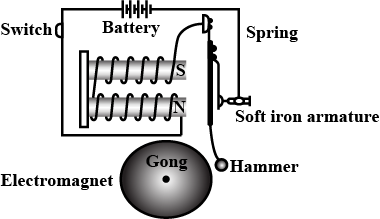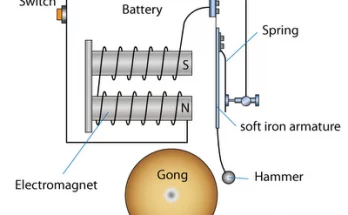Class 7 Science introduces students to various fascinating concepts, one of which is the electric bell. Understanding the electric bell, especially through its diagram, is crucial for students to grasp the basics of electromagnetism and circuitry. This article will guide you through the electric bell diagram, making it simple and interesting for Class 7 students.
Table of Contents
The Electric Bell
An electric bell is a common application of electromagnets found in schools and homes. It operates on principles of electric current and magnetism to produce sound. The key components that make up an electric bell are the electromagnet, armature, spring, clapper, and gong.
Detailed Electric Bell Diagram

The diagram show the components The battery, switch, and electromagnet form the circuit. The armature (hammer) is placed close to the electromagnet, with one end attached to the clapper and the other to the spring. The gong is positioned to be struck by the clapper.
The Electric Bell – Components Explained
An electric bell is an excellent example of how electromagnetism is used in everyday devices. Let’s break down its components:
- Electromagnet: A coil of wire around an iron core, becoming magnetized when current flows through it.
- Armature (Hammer): An iron bar attached to the clapper, also known as the hammer. It moves to hit the gong.
- Spring: Connects to the armature, helping it return to the original position.
- Clapper: The part of the armature that strikes the gong.
- Gong: The metal piece that produces the bell sound when hit by the clapper.
- Battery: Provides the electric current needed for the electromagnet.
- Switch: Controls the flow of electricity to the electromagnet.
Also Check – Electric Bell Working Mechanism Simplified for Students
Functionality of an Electric Bell
Here’s how each component plays a role:
- Switch Activation: When the switch is turned on, it completes the circuit.
- Electromagnet: The current from the battery magnetizes the electromagnet.
- Armature Movement: The magnetized electromagnet attracts the armature, causing the clapper (hammer) to hit the gong.
- Circuit Break and Reset: The movement of the armature breaks the circuit, demagnetizing the electromagnet. The spring then pulls the armature back, remaking the circuit.
- Repetition: This process repeats rapidly as long as the switch is on, causing continuous ring
The electric bell is a fundamental example illustrating how electricity can be converted into mechanical energy. It helps students understand the principles of electromagnetism in a practical setting.
Also Check- Batteries- The Powerhouses of Everyday Life – A Guide for Upper Primary Students
Also Check- Electromagnets- A Guide for Upper Primary Students
Also Check- Rapid Revision – Class 7 Science- Chapter 14 – Electric Current and Its Effects
Also Check- Chapter 14- Electric Current and Its Effects-Class 7 science- Question and Answers
Also Check- Chapter 14- Electric Current and Its Effects–Class 7 science- Question and Answer -(Solved MCQs)
Also Check- NCERT Exemplar Solutions- Class 7 Science- Chapter 14 – Electric Current and Its Effects
Also Check- NCERT Solutions for Class 7 Science Chapter 14- Electric Current and its Effects
Also Check- Class 7 science -Chapter 14 – Electric Current and Its Effects- Complete NotesAlso Check- Class 7 – Science- Chapter 14 – Electric Current and its Effects -Definition and Explanation of Important Keywords
